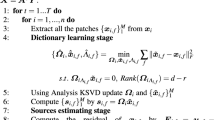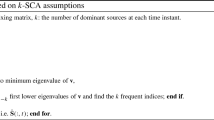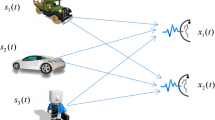Abstract
The underdetermined blind source separation problem is a common problem in our daily life, but it is difficult to solve because of its underdetermined. In the literature, sparse component analysis which exploits the sparsity of sources in a predefined sparse dictionary has been proposed to solve it. Usually, sparse component analysis uses a two-stage approach. The first stage is to estimate the mixing matrix and the second stage is to reconstruct sources. In fact, the second stage is a sparse optimization problem. In this paper, we model the problem of reconstructing sources as a bi-objective optimization problem. We take the error and sparsity as the two optimization objectives, and propose an iterative algorithm based on mixed integer programming to solve the bi-objective source reconstructing problem. Experimental results show the accuracy and effectiveness of our proposed algorithm.
Access this chapter
Tax calculation will be finalised at checkout
Purchases are for personal use only
Similar content being viewed by others
References
SySed MN, Georgiev PG, Pardalos PM (2014) A hierarchical approach for sparse source blind signal separation problem. Comput Oper Res 41:386–398
Wang F, Li R, Wang Z et al (2015) Improved blind recovery algorithm for underdetermined mixtures by compressed sensing. Adv Swarm Comput Intell 405–412
He Z, Cichocki A, Li Y et al (2009) K-hyperline clustering learning for sparse component analysis. Signal Process 89(6):1011–1022
Georgiev PG, Theis F, Cichocki A (2005) Sparse component analysis and blind source separation of underdetermined mixtures. IEEE Trans Neural Netw 16(4):992–996
Bobin J, Rapin J, Larue A et al (2015) Sparsity and adaptively for the blind separation of partially correlated sources. IEEE Trans Signal Process 63(5):1199–1213
Bourguignon S, Ninin J, Carfantan H et al (2016) Exact sparse approximation problems via mixed-integer programming: formulations and computational performance. IEEE Trans Signal Process 64(6):1405–1419
Li H, Su X, Xu Z et al (2012) MOEA/D with iterative thresholding algorithm for sparse optimization problems. In: Parallel problem solving from nature-PPSN XII, pp 93–101
Amini F, Hedayati Y (2016) Underdetermined blind modal identification of structures by earthquake and ambient vibration measurements via sparse component analysis. J Sound Vib 366:117–132
Ehrgott M (2005) Multicriteria optimization. Springer Science & Business Media
Yu XC, Cao TT, Hu D et al (2010) Blind image separation based on wavelet transformation and sparse component analysis. J Beijing Univ Posts Telecommun 33(2):58–63
Branke J, Deb K, Dierolf H, et al. (2004) Finding knees in multi-objective optimization. In: International Conference on Parallel Problem Solving from Nature, pp 722–731
Author information
Authors and Affiliations
Corresponding author
Editor information
Editors and Affiliations
Rights and permissions
Copyright information
© 2016 Springer Science+Business Media Singapore
About this paper
Cite this paper
Fan, X., Shao, L. (2016). Blind Source Separation Based on Mixed Integer Programming. In: Jia, Y., Du, J., Zhang, W., Li, H. (eds) Proceedings of 2016 Chinese Intelligent Systems Conference. CISC 2016. Lecture Notes in Electrical Engineering, vol 405. Springer, Singapore. https://doi.org/10.1007/978-981-10-2335-4_55
Download citation
DOI: https://doi.org/10.1007/978-981-10-2335-4_55
Published:
Publisher Name: Springer, Singapore
Print ISBN: 978-981-10-2334-7
Online ISBN: 978-981-10-2335-4
eBook Packages: Computer ScienceComputer Science (R0)




